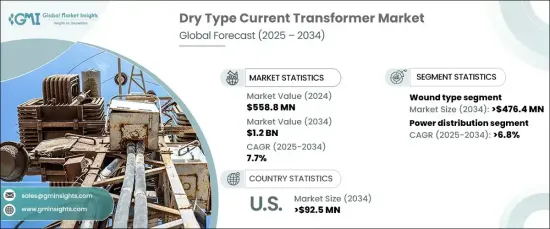PUBLISHER: Global Market Insights Inc. | PRODUCT CODE: 1666644

PUBLISHER: Global Market Insights Inc. | PRODUCT CODE: 1666644
Dry Type Current Transformer Market Opportunity, Growth Drivers, Industry Trend Analysis, and Forecast 2025 - 2034
The Global Dry Type Current Transformer Market was valued at USD 558.8 million in 2024 and is projected to grow at a robust CAGR of 7.7% from 2025 to 2034. The market is being fueled by several key factors, including the increasing demand for energy-efficient solutions, the global trend toward renewable energy adoption, and the modernization of power grid infrastructures. With urbanization continuing at a rapid pace, the need for safer and more sustainable transformers is greater than ever.

Dry-type current transformers, with their non-oil insulation systems, are proving to be a game-changer. These transformers mitigate fire hazards and reduce the risk of environmental contamination, making them ideal for indoor installations and sensitive environments where safety is a top priority. As the global emphasis shifts towards reducing environmental impact and enhancing grid reliability, dry-type transformers provide the perfect solution to meet the growing demand for safer, more efficient power distribution systems.
| Market Scope | |
|---|---|
| Start Year | 2024 |
| Forecast Year | 2025-2034 |
| Start Value | $558.8 Million |
| Forecast Value | $1.2 Billion |
| CAGR | 7.7% |
Innovative developments in the dry-type current transformer market are helping manufacturers stay ahead of the curve. There is a growing trend of integrating advanced insulation materials, such as epoxy resin, which not only enhances the thermal performance but also improves moisture and contaminant resistance. Additionally, the rise of smart monitoring systems is revolutionizing the way transformers are managed. These systems allow real-time data collection and predictive maintenance, aligning with the broader trend of digitalizing energy management and modernizing electrical grids. The increasing focus on these intelligent systems will help improve operational efficiency and reduce downtime, which is crucial for energy reliability.
The wound-type current transformer market, a key segment within the industry, is expected to generate USD 476.4 million by 2034. This segment benefits from the growing need for precise and reliable current measurements in power distribution networks. Wound-type transformers, typically used in high-voltage applications such as power transmission systems and substations, offer exceptional accuracy, efficiency, and cost-effectiveness. Their ongoing advancement, particularly in materials such as high-end magnetic substances and protective coatings, is further enhancing their durability and overall performance.
As for the power distribution sector, it's projected to experience a CAGR of 6.8% through 2034. The rising demand for smart grids and the continuing evolution of grid modernization are driving this growth. Dry-type current transformers are pivotal in providing accurate current measurement and monitoring within these advanced power distribution systems. They enable the management of more complex grids, ensuring efficiency and reliability in energy distribution.
In the U.S., the dry-type current transformer market is expected to generate USD 92.5 million by 2034. This growth is largely attributed to the country's ongoing focus on modernizing its electrical grid, the increasing integration of renewable energy sources, and a growing demand for environmentally friendly and secure power distribution solutions. Dry-type transformers are crucial in ensuring the accuracy and reliability of power systems, helping to maintain the stability and performance of the U.S. power grid.
Table of Contents
Chapter 1 Methodology & Scope
- 1.1 Market definitions
- 1.2 Base estimates & calculations
- 1.3 Forecast calculation
- 1.4 Data sources
- 1.4.1 Primary
- 1.4.2 Secondary
- 1.4.2.1 Paid
- 1.4.2.2 Public
Chapter 2 Executive Summary
- 2.1 Industry synopsis, 2021 – 2034
Chapter 3 Industry Insights
- 3.1 Industry ecosystem analysis
- 3.2 Regulatory landscape
- 3.3 Industry impact forces
- 3.3.1 Growth drivers
- 3.3.2 Industry pitfalls & challenges
- 3.4 Growth potential analysis
- 3.5 Porter's analysis
- 3.5.1 Bargaining power of suppliers
- 3.5.2 Bargaining power of buyers
- 3.5.3 Threat of new entrants
- 3.5.4 Threat of substitutes
- 3.6 PESTEL analysis
Chapter 4 Competitive landscape, 2024
- 4.1 Strategic dashboard
- 4.2 Innovation & sustainability landscape
Chapter 5 Market Size and Forecast, By Product, 2021 – 2034 (‘000 Units & USD Million)
- 5.1 Key trends
- 5.2 Wound type
- 5.3 Toroidal
- 5.4 Bar type
- 5.5 Others
Chapter 6 Market Size and Forecast, By Voltage Rating, 2021 – 2034 (‘000 Units & USD Million)
- 6.1 Key trends
- 6.2 ≤ 33 kV
- 6.3 > 33 kV to ≤ 66 kV
- 6.4 > 66 kV
Chapter 7 Market Size and Forecast, By Application, 2021 – 2034 (‘000 Units & USD Million)
- 7.1 Key trends
- 7.2 Power distribution
- 7.3 Manufacturing
- 7.4 Others
Chapter 8 Market Size and Forecast, By Region, 2021 – 2034 (‘000 Units & USD million)
- 8.1 Key trends
- 8.2 North America
- 8.2.1 U.S.
- 8.2.2 Canada
- 8.2.3 Mexico
- 8.3 Europe
- 8.3.1 UK
- 8.3.2 France
- 8.3.3 Germany
- 8.3.4 Italy
- 8.3.5 Russia
- 8.3.6 Spain
- 8.4 Asia Pacific
- 8.4.1 China
- 8.4.2 Australia
- 8.4.3 India
- 8.4.4 Japan
- 8.4.5 South Korea
- 8.5 Middle East & Africa
- 8.5.1 Saudi Arabia
- 8.5.2 UAE
- 8.5.3 Turkey
- 8.5.4 South Africa
- 8.5.5 Egypt
- 8.6 Latin America
- 8.6.1 Brazil
- 8.6.2 Argentina
Chapter 9 Company Profiles
- 9.1 ABB
- 9.2 Amran
- 9.3 ARTECHE
- 9.4 Automatic Electric
- 9.5 Dalian Huayi Electric Power Electric Appliances
- 9.6 General Electric
- 9.7 Guangdong Sihui Instrument Transformer Works
- 9.8 Hitachi Energy
- 9.9 Instrument Transformers
- 9.10 Macroplast
- 9.11 Peak Demand
- 9.12 Siemens Energy
- 9.13 TWB
- 9.14 Wenzhou Unisun Electric




